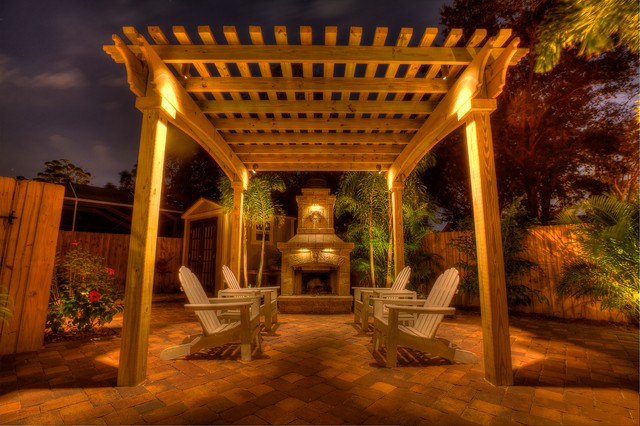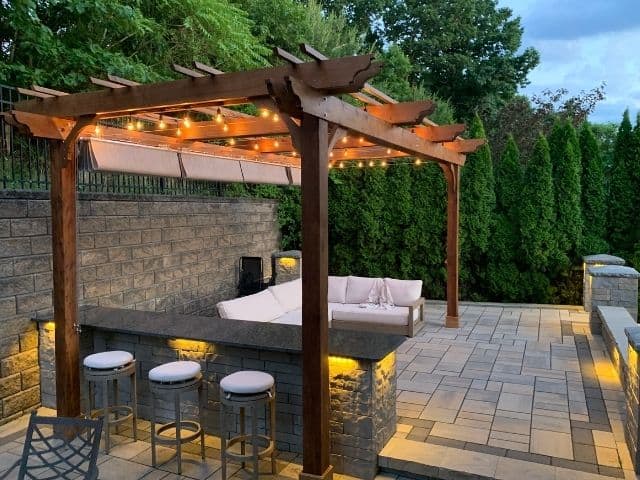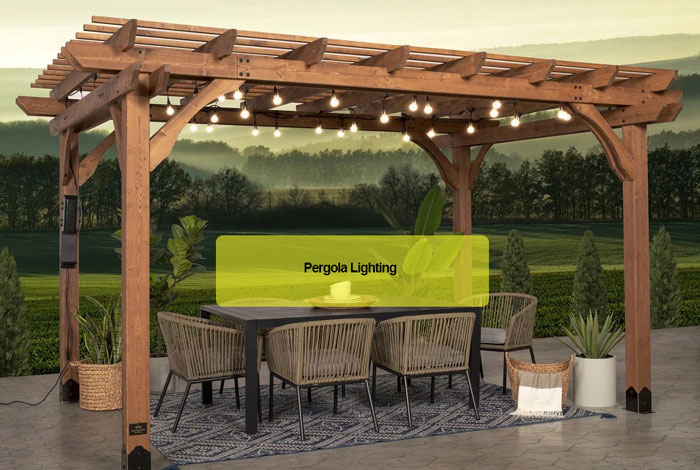The term “Pergola” was first used by Roman architects and designers in the 1600s. A pergola is a structure designed as a covered pathway, porch, or freestanding structure. It is typically constructed in gardens, covered with robust latticework, supported by columns or posts, and sometimes cantilevered from a building. Vines such as grapes are then planted at the base of the pergola to climb up the structure as a natural covering.
This beauty, romance, and luxury call attention to itself during the day as it should during the night with lighting. In Roman times, they were illuminated by torches, moonlight, and sunlight. Today, there is a variety of luminaires available for pergola lighting.
In the following sections, we will look at some tips and ideas to transform your pergola with lighting.
Pergola Lighting: Designing
It is best to think of a pergola as a path or as a spot of relaxation and pleasure. These structures have few if any walls for reflecting lighting and often no ceiling surface. A lack of reflecting surfaces, however, can be an advantage in that there is complete freedom to create the desired mood with lighting.
Determine the use or variety of uses to be made of the structure; keep this in mind when selecting lighting. In general, however, relaxation of the outdoors is the most common approach. A relaxing mood is established by the softness of the lighting.
Sufficient illumination is required to;
- Allow people to see each other
- Light the furniture
- Prevent stumbling and collision in the dark
While a low-wattage flood lamp that washes the entire area may give the effect of a soft light, it might not be attractive or interesting. Rather, it might tend to be flat and may cause glare. The flatness of floodlighting should be countered with accent lights to add contrast and interest.
Numerous hanging, wall-mounted, and in-ground fixtures are available for pergola lighting. Inground concealed up lighters illuminate the column or pedestal and volume.
The opportunity to softly downlight a pergola exists provided they are sufficiently spaced to allow an interplay of light and soft shadows. Features within the pergola such as a statue could benefit from overhead lighting. If you have seating within a pergola, you may want to provide it with downlighting.
Provide enough for whatever specific purpose the light is intended, but not so much tha it is not possible to see outside into other parts of the garden.
Another aspect to consider with pergola lighting is the view as seen from the living room or wherever there is an interior room with a large window or sliding glass door opening onto the patio with a pergola. Good lighting creates the illusion of enlarging the room connected to the patio.
If the pergola is elevated from adjoining garden areas, the night view can be enhanced by lights mounted on the beams and directed toward the garden area.
Be sure the lighting is compatible with the indoor and outdoor lighting.
The addition of a dimmer controls the intensity of lighting to create the desired mood.

Fixture Installation
Lighting Installation will include running conduit and wiring, hiding wires, and installing a transformer to lower the electric voltage.
Since most pergolas are situated on stone or pre-cast concrete pavers, brick or poured concrete, running conduit, and wiring require tunneling under the hard surface. Wires may need to be hidden by drilling into wooden posts
This is best done during construction by a skilled lighting contractor for easier execution and artistic and functional design.
9 Pergola Lighting Ideas
Lanterns:
Available in various styles, colors, and sizes, hanging lanterns provide a gentle glow. They can be electric, solar-powered, or candlelit adding a boho flair to the design.
They not only provide ambient lighting but also contribute to the overall look. These lanterns can be used individually or clustered together.
Pillar Candles:
Candles placed in lanterns or on tables set a romantic ambiance. The flame creates an inviting atmosphere for relaxation.
An alternative is LED candles that will create a warm and inviting atmosphere.
Pendant Lights:
Consider hanging outdoor pendant lights in your pergola. They can be suspended over a table or seating area.
Post-Mounted Sconces:
Mount sconces on the outside of the pergola posts to provide stylish and safe perimeter lighting.

String or Festoon Lights:
Suspending string or bistro lights from overhead beams add a magical sparkle to your pergola. Calculate the required length to ensure the purchase of the appropriate strands.
Festoon lights will make it feel like you are sitting under a starry sky. Use them as downlighting to create a festive atmosphere for your pergola.
Strip lights:
For a sleek and seamless lighting option, consider using LED strip lights. These modern lights can be effortlessly integrated into your existing pergola, providing a subtle glow.
Install the strips along your ceiling structure for flattering downlighting or against your vertical beams for an upward glow.
Firepit:
Incorporate a firepit into your pergola to provide both lighting and warmth. It’s the perfect spot for storytelling or relaxation.

Landscape Lighting:
Extend the lighting effect beyond the pergola by adding landscape lighting to the surrounding garden area. Light water features, small trees, shrubs, statues, and so on accentuate their beauty as part of the whole composition.
Smart Lighting:
There is an array of smart lighting options, ranging from timer controls, zoning, color control, photosensor control smartphone control, and voice activation for automation and maximum flexibility. You can customize the lighting to suit your preferences.


